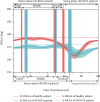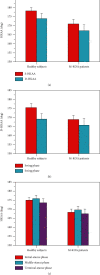A Comparison of Dynamic and Static Hip-Knee-Ankle Angle during Gait in Knee Osteoarthritis Patients and Healthy Individuals
- PMID: 34853606
- PMCID: PMC8629624
- DOI: 10.1155/2021/6231406
A Comparison of Dynamic and Static Hip-Knee-Ankle Angle during Gait in Knee Osteoarthritis Patients and Healthy Individuals
Abstract
Malalignment of the lower limbs is the main biomechanical factor for knee osteoarthritis (KOA). The static hip-knee-ankle angle (S-HKAA) measured from radiograph is regarded as the "gold standard" of the malalignment. However, many evidences showed that the S-HKAA has no significant correlation with the knee dynamic-load distribution, unlike the dynamic HKAA (D-HKAA). The purpose of this study was to quantitatively analyze the D-HKAA and investigate the relationship between D-HKAA and S-HKAA for both KOA and healthy participants. In this paper, twenty-five healthy subjects and twenty-five medial compartment KOA (M-KOA) patients were recruited. Three-dimensional motion analysis and standing lower-limbs-full-length radiograph were utilized to obtain the D-HKAA and S-HKAA, respectively. The results showed that the mean D-HKAA was more varus than the S-HKAA (p < 0.05). For the mean D-HKAA, larger varus angle was observed in swing phase than stance phase (p < 0.05). Compared with healthy subjects, the M-KOA patients had remarkably smaller S-HKAA and D-HKAA during gait cycle (p < 0.01). For the relationship between the S-HKAA and mean D-HKAA, no significant correlation was found for both healthy subjects and M-KOA patients (r < 0.357, n = 25, p > 0.05, Spearman correlation analysis). In conclusion, the S-HKAA was limited to predict the D-HKAA for both M-KOA patients and healthy subjects. The D-HKAA should be given more attention to the orthopedist and the designer of knee brace and orthotics.
Copyright © 2021 Li Zhang et al.
Conflict of interest statement
The authors declare that they have no conflicts of interest.
Figures





Similar articles
-
Predicting the mechanical hip-knee-ankle angle accurately from standard knee radiographs: a cross-validation experiment in 100 patients.Acta Orthop. 2020 Dec;91(6):732-737. doi: 10.1080/17453674.2020.1779516. Epub 2020 Jun 22. Acta Orthop. 2020. PMID: 32567436 Free PMC article.
-
Acute effects of different orthotic interventions on knee loading parameters in knee osteoarthritis patients with varus malalignment.Knee. 2018 Oct;25(5):825-833. doi: 10.1016/j.knee.2018.06.017. Epub 2018 Jul 17. Knee. 2018. PMID: 30017510
-
Radiologists should use the hip-knee-ankle angle rather than the mechanical axis deviation to describe knee alignment.Skeletal Radiol. 2023 Jun;52(6):1159-1167. doi: 10.1007/s00256-022-04234-y. Epub 2022 Nov 14. Skeletal Radiol. 2023. PMID: 36374317
-
Characteristics of frontal plane lower limb movement during walking in patients with knee osteoarthritis of varying severity.J Orthop Surg (Hong Kong). 2019 May-Aug;27(2):2309499019848085. doi: 10.1177/2309499019848085. J Orthop Surg (Hong Kong). 2019. PMID: 31117881
-
Contributions to the understanding of gait control.Dan Med J. 2014 Apr;61(4):B4823. Dan Med J. 2014. PMID: 24814597 Review.
Cited by
-
Inertial Sensor-to-Segment Calibration for Accurate 3D Joint Angle Calculation for Use in OpenSim.Sensors (Basel). 2022 Apr 24;22(9):3259. doi: 10.3390/s22093259. Sensors (Basel). 2022. PMID: 35590949 Free PMC article.
-
The HKA axis varies significantly with knee motion: A robot-assisted intraoperative evaluation during total knee arthroplasty supports the use of dynamic, not static, alignment classifications.J Exp Orthop. 2025 Jul 18;12(3):e70370. doi: 10.1002/jeo2.70370. eCollection 2025 Jul. J Exp Orthop. 2025. PMID: 40689101 Free PMC article.
-
Comparison of knee biomechanical characteristics during gait between patients with knee osteoarthritis and healthy individuals.Heliyon. 2024 Aug 26;10(17):e36931. doi: 10.1016/j.heliyon.2024.e36931. eCollection 2024 Sep 15. Heliyon. 2024. PMID: 39281588 Free PMC article.
-
Prediction of In Vivo Knee Mechanics During Daily Activities Based on a Musculoskeletal Model Incorporated with a Subject-Specific Knee Joint.Bioengineering (Basel). 2025 Feb 5;12(2):153. doi: 10.3390/bioengineering12020153. Bioengineering (Basel). 2025. PMID: 40001673 Free PMC article.
References
-
- Han X. Q., Cui J. Q., Xie K., et al. Association between knee alignment, osteoarthritis disease severity, and subchondral trabecular bone microarchitecture in patients with knee osteoarthritis: a cross-sectional study. Arthritis Research and Therapy . 2020;22(1):p. 203. doi: 10.1186/s13075-020-02274-0. - DOI - PMC - PubMed
-
- Sheehy L., Felson D., Zhang Y., et al. Does measurement of the anatomic axis consistently predict hip-knee-ankle angle (HKA) for knee alignment studies in osteoarthritis? Analysis of long limb radiographs from the multicenter osteoarthritis (MOST) study. Osteoarthritis and Cartilage . 2011;19(1):58–64. doi: 10.1016/j.joca.2010.09.011. - DOI - PMC - PubMed
LinkOut - more resources
Full Text Sources

